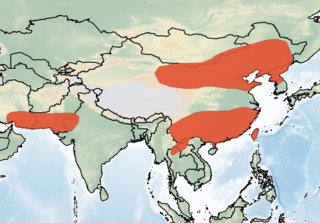Cnemaspis heteropholis, also known as the Gund day gecko or different-scaled day gecko, is a species of geckos found in India.

Chalcides pentadactylus, or five-fingered skink, is a species of skink found in the Western Ghats of India. Females of other species of the genus are viviparous, meaning that they give birth to live young. Almost nothing is known of C. pentadactylus. It is only known from the holotype which is lost [ fide Smith 1935]. Due to the loss of the only known specimen the true identity and origin of this skink, and its correct generic assignment, must await the examination of fresh material.

The two-lined ground skink is a species of skink. It is found in the Nilgiri Hills and Travancore Hills of India.

Kaestlea travancorica, also known as the Travancore ground skink or Barbour's ground skink, is a species of skink endemic to southern Western Ghats.
The mountain noctule is a species of bat found in Afghanistan, India, Pakistan, and Nepal.
The Sind bat is a species of vesper bat and the only member of the genus Rhyneptesicus. It inhabits forests and arid areas near waterbodies in southwestern Saudi Arabia, Yemen and Oman, around the coast of the Gulf of Oman in southern Iraq and Iran. Isolated populations in southern Pakistan and northwestern Afghanistan occur up to an elevation of 862 m (2,828 ft). Its presence in Bahrain, Qatar and the United Arab Emirates is uncertain.

The thick-eared bat is a species of vesper bat native to China, India, Myanmar, Bangladesh and Thailand. Very little is known about the status and ecology of this bat, except that it may prefer to inhabit tropical moist deciduous forests.
Dormer's bat or Dormer's pipistrelle is a species of vesper bat. It is the only species in its genus. It is found in Bangladesh, Bhutan, India, and Pakistan. Its natural habitats are subtropical and tropical dry forests, arable land, plantations, rural gardens, and urban areas.
The desert yellow bat is a species of vesper bat. It is found in India, Pakistan, and Bangladesh. Its natural habitats are subtropical or tropical dry forests and shrubland, rural gardens, and urban areas.

The Kolar leaf-nosed bat, or leafletted leaf-nosed bat is a species of bat in the family Hipposideridae. It is endemic to India. Its natural habitats are subtropical or tropical dry forests and caves. It is found in only one cave in India, and its population is less than 200 individuals.

The Indian pipistrelle is a species of bat in the family Vespertilionidae found in Afghanistan, Bangladesh, Bhutan, Cambodia, India, Myanmar, Nepal, Pakistan, Sri Lanka, Thailand, and Vietnam.

Pulchrana laterimaculata, also known as the side-spotted swamp frog, is a species of "true frog", family Ranidae. It is found on the Malay Peninsula from the southernmost Thailand through Malaysia to Singapore, in Sarawak in Borneo, and on the Natuna Besar island in the Indonesian part of the South China Sea.

Kaestlea is a genus of skinks. These skinks are small, shiny, smooth-scaled species. They are diurnal, terrestrial and insectivorous. They lay eggs to reproduce. These skinks are identified by their distinct blue tail colour. They live in tropical rainforest and montane forest habitats. These secretive skinks silently move through thick leaf-litter on forest floor. They are all endemic to the Western Ghats mountains and in some parts of Eastern Ghats (Shevaroys) of South India.

Myotis annatessae is a recently described species of bat in the family Vespertilionidae. It is endemic to Vietnam and Laos.

The Turkmen long-eared bat is a species of bat in the family Vespertilionidae. It is found in Kazakhstan, Uzbekistan and Turkmenistan, and possibly Mongolia.
The Himalayan long-eared bat, also known as Hodgson's long-eared bat, is a species of bat in the family Vespertilionidae. It is ranges from the Indian subcontinent east to China and south to Vietnam.

The Oriental serotine is a species of bat in the family Vespertilionidae. It is widespread and found throughout Asia.

Kaestlea beddomii, also known as Beddome's ground skink, is a species of lizard in the family Scincidae. The species is endemic to the Western Ghats of India.
The Palni Hills ground skink is a species of skink found in India.
Ognev's serotine is a species of vesper bat found in western and central Asia.












